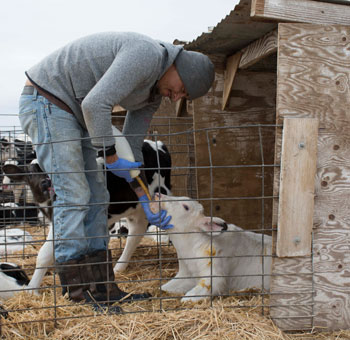
Growing up on my family’s dairy farm, more than once I had the opportunity to give a slippery, wet newborn calf its very first meal. I always knew that colostrum was important, but over time I’ve learned more and more reasons why that first meal may very well be the most significant meal a calf will ever receive.
In most situations, colostrum from the calf’s dam is best. There are times, though, when fresh colostrum may not be an option. Perhaps the cow is a carrier of Johne’s disease or another infection that we don’t want to pass on to the calf. Maybe the colostrum was collected but got contaminated or isn’t of high enough quality. And on some farms it is difficult to collect colostrum soon enough to feed calves within the recommended six hours after birth.
When fresh or frozen colostrum isn’t available, another useful option is a colostrum replacement. These replacers come in powder form and are mixed with warm water to create that first colostrum feeding.
University of Minnesota’s Sandra Godden, D.V.M., spent a few minutes talking about colostrum replacers during her presentation at the Dairy Calf and Heifer Association’s Annual Meeting held last week in Milwaukee, Wis.
“Colostrum replacers are handy to have around,” Godden said. She offered some advice on what to look for in a replacer.
First, she said to determine if the replacer is colostrum derived or serum or plasma derived. This means that the immunoglobulins (IgG) come from sprayed dried colostrum or sprayed dried serum or plasma. Based on research, IgG absorption seems to be more efficient when the source is colostrum derived.
Godden said that producers don’t need to avoid serum or plasma derived products; they just need to feed more of it to reach the same level of IgG absorption.
Secondly, the dose is important. Godden said, “The goal is to get 150 to 200 grams of IgG per dose of colostrum, and the same holds true for colostrum replacers.”
A typical colostrum replacer does not contain 200 grams of IgG. “If you really want to match mom,” Godden said, “you’ll have to bump up the dose.”
She shared a University of Minnesota study, in which they fed calves one bag, one and a half bags, or two bags of a colostrum replacer that contained 100 grams of IgG. Measuring serum IgG levels in the calf, they found that 54 percent of calves fed one bag of replacer had failure of passive transfer. Of the calves fed one and a half bags, only 5 percent failed.
The calves fed two bags of replacer all had successful passive transfer, matching the group of calves fed four quarts of colostrum. Studies like this show that replacers can be used successfully as a first meal for calves, as long as enough is fed to achieve passive transfer goals.

The author is an associate editor and covers animal health, dairy housing and equipment, and nutrient management. She grew up on a dairy farm near Plymouth, Wis., and previously served as a University of Wisconsin agricultural extension agent. She received a master’s degree from North Carolina State University and a bachelor’s from University of Wisconsin-Madison.








